During our many visits to Cambodia and the two stints of living there, we made it our mission to visit and write about the more off-the-beaten-track, less touristy destinations. We aim to encourage people to spend longer in Cambodia to experience what it has to offer away from the tourist trail.
Two of our favourite destinations are the sleepy towns of Kampot and Kep, in Southwest Cambodia, two of the last of Cambodia’s colonial towns. Riverside Kampot and seaside Kep are just 20 km apart, which means they are ideal to combine in one trip; exactly what Andy and I have done many times over more than a decade of visiting and living in Cambodia.
On our most recent trip, we took my Dad to discover Kampot and Kep, both the charming off-the-beaten-track towns and their surrounding area.
Affiliate Link Disclosure: This post contains affiliate links. If you use them to make a purchase, we may earn a small commission at no extra cost to you. As an Amazon Associate, we earn from qualifying purchases. Learn more in our Affiliate Link Disclosure.
Kampot and Kep
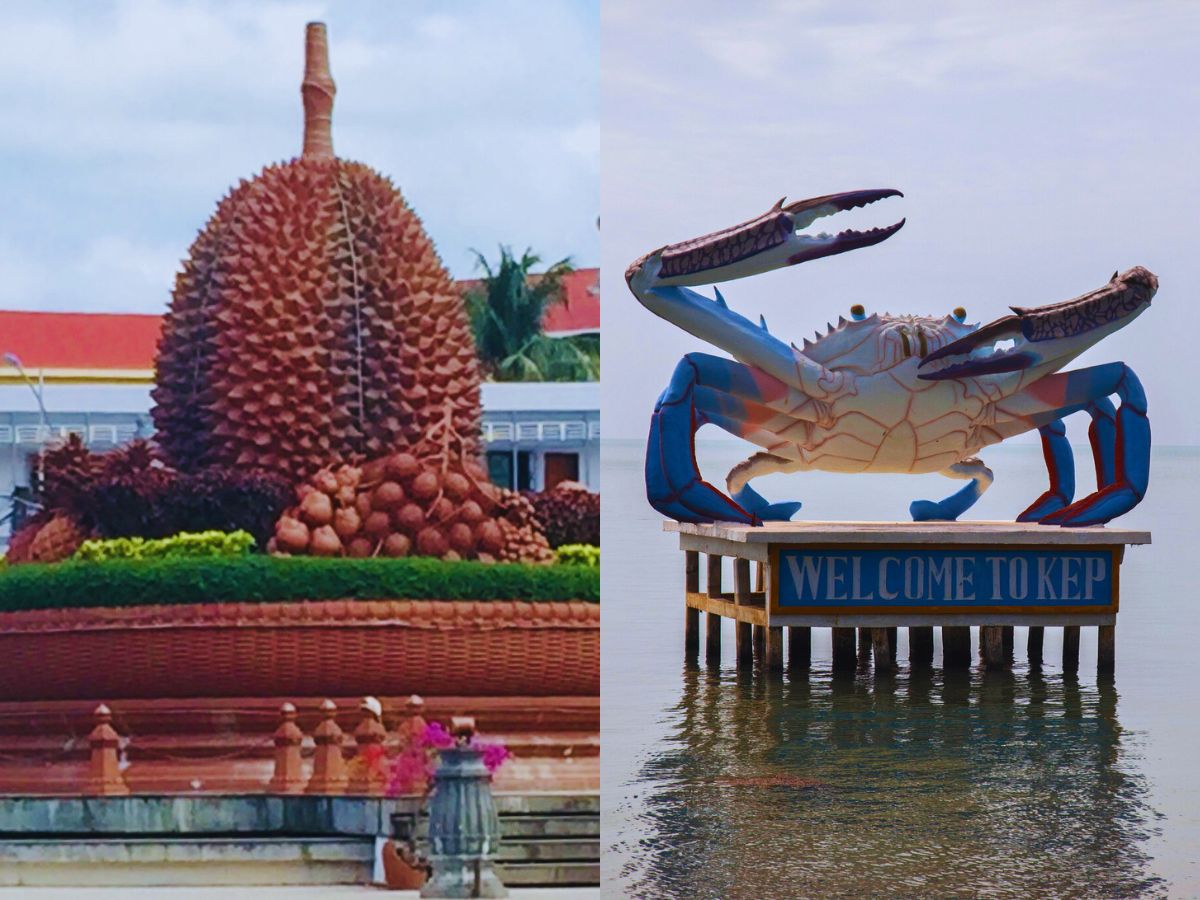
Despite being a popular getaway for those in the know (i.e. mainly expats living in Phnom Penh and Siem Reap) the towns of Kampot and Kep, often get overlooked by travellers.
Close to each other, about 30 – 45 minutes apart depending on your mode of transport, it’s possible to stay in either town and easily explore both. Due to the proximity of the two towns and the fact that they share many nearby attractions I’ve decided to cover both of them in this post.
So let’s delve in and discover everything that Kampot and Kep have to offer. This includes recommendations on where to eat, where to stay and how to get there, all based on our most recent experiences in the towns.
Best Things to See and Do in Kampot and Kep
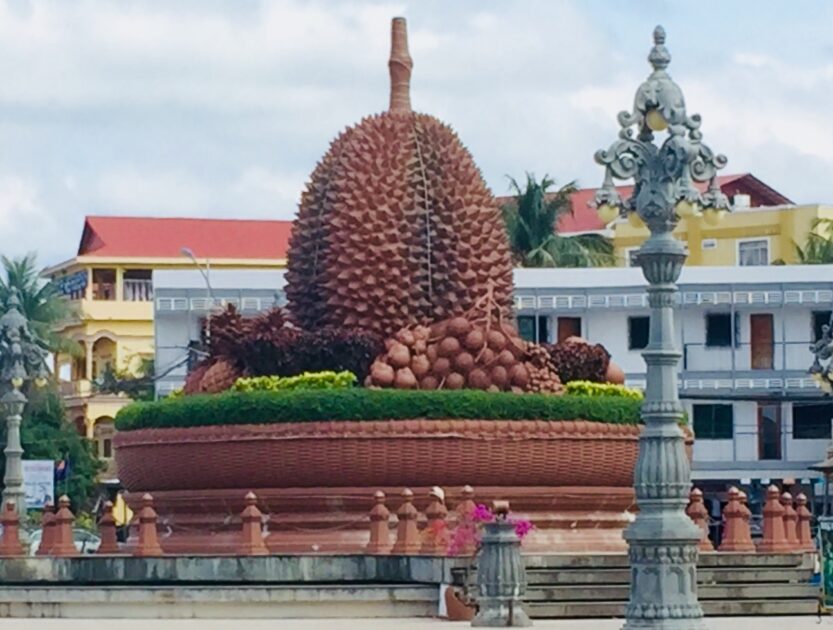
Kampot itself, with its landmark Durian roundabout, doesn’t have a huge array of things to see and do, yet this is part of its charm. The chilled vibe makes it the perfect place for some downtime.
If, and when you get bored of doing not a lot, there’s always the option to venture outside of Kampot, where there’s plenty to keep you occupied.
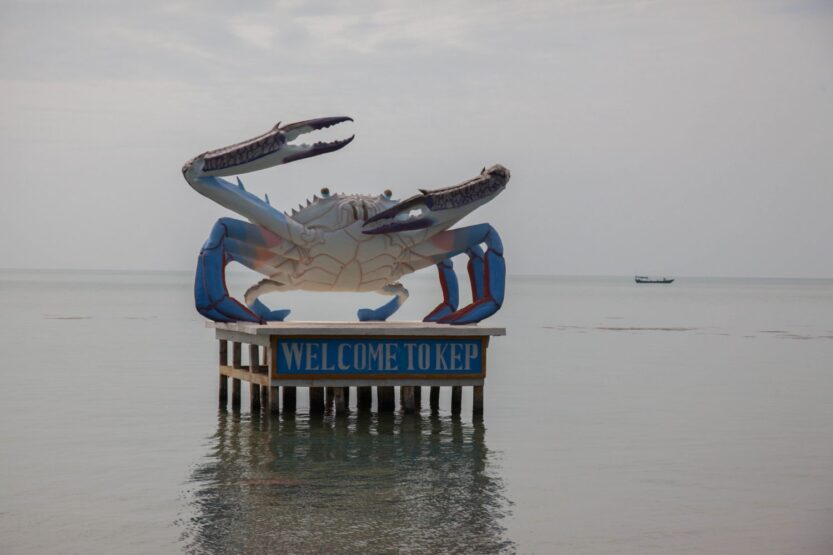
For us, this included trips to nearby Kep with its giant blue crab statues (just offshore and on the roundabout) and Koh Tonsay (Rabbit Island).
Riverside and Beachside Walks
Kampot’s a sleepy town, known for its quiet setting alongside the Praek Teuk Chhu River and a riverside walk is a relaxing way to while away an hour or two. Time it for dusk and you may be treated to a stunning sunset over the river and surrounding hills. This is also the best time for people-watching as many locals also go for an evening stroll, speed walk, or jog.
Despite not being one of the nicest beaches in Cambodia, Kep Beach is very popular with locals. Again a walk along it is a great way to see and join local and holidaying Cambodians enjoying their spare time.
A word of warning, if you visit during or on either side of a public holiday, such as the Water Festival or Khmer New Year, as we did, expect it to be heaving and full of rubbish. Not a particularly enjoyable experience, but when we returned the next day it had all been cleaned up. It was peaceful and quiet and could have been mistaken for a completely different place.
Countryside Tuk Tuk Tour
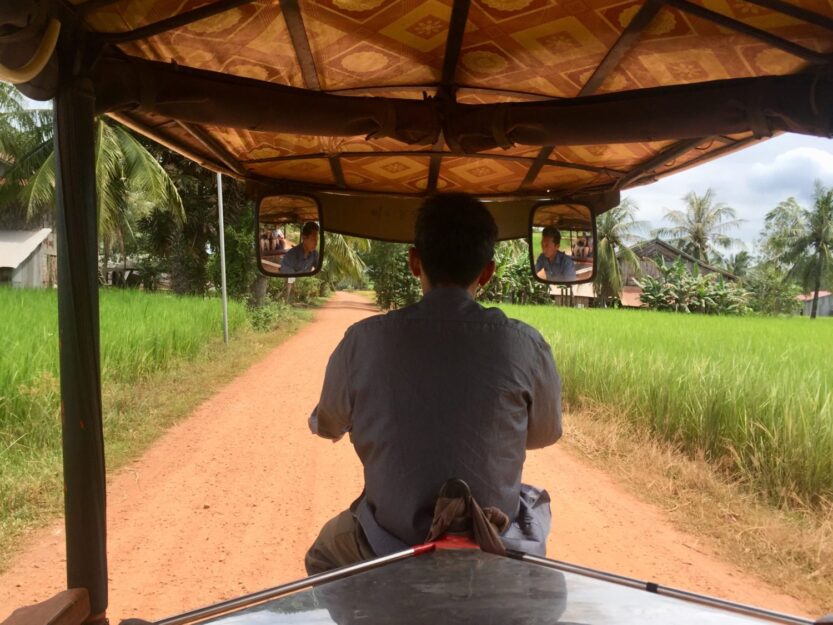
The best way to see most of the sights around Kampot and Kep is via a half or full-day countryside tuk tuk tour from either town. In addition to the things to see and do that I mention below, the actual journey through the beautiful Cambodian countryside itself is amazing, if a little bumpy. You get to see rural Cambodia and it’s wonderful people at their best! Dad and I took a full-day tour.
Pepper Plantations
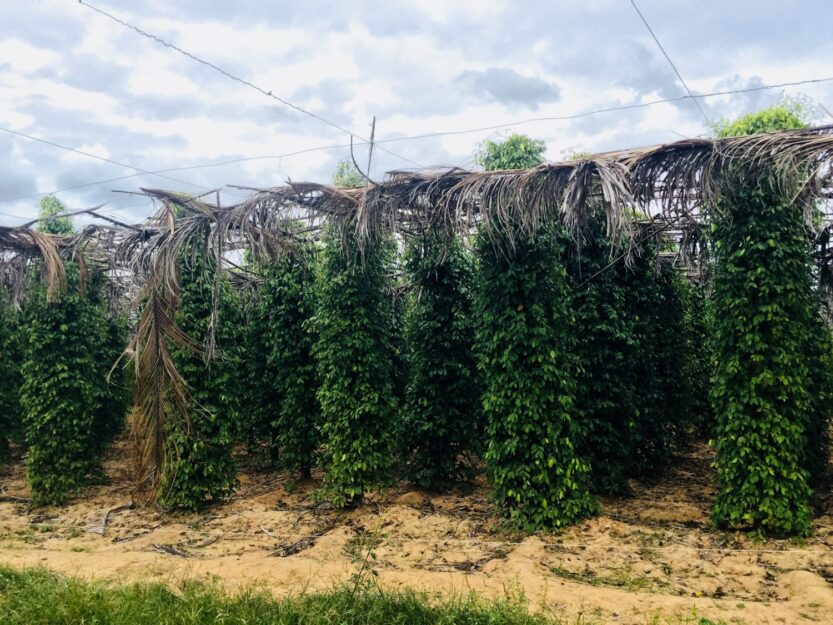
Kampot is most well known for its world-renowned Kampot Pepper. This pepper is produced in several hundred organic farms set at the base of mountains in the area. There are several farms you can visit ranging from small family-run ventures such as the one Andy and I visited during our first time in Kampot nine years ago, all the way to huge plantations stretching more than 20 hectares.
This time Dad and I visited La Plantation because this was where our tuk tuk driver took us. It was set up and is run by a French couple who train and employ many locals.
The plantation has a beautiful countryside setting with views over the plantation, hills, lake, and Bokor mountain. They offer an interesting free presentation about the pepper growing process, including a taster of each type of pepper. Afterwards, there’s a free guided tour of the plantation which again we found really interesting.
The presentation takes place in a huge wooden Khmer-style house on stilts. This also houses a restaurant and a gift shop where you can buy refreshments, a bite to eat, or a peppery souvenir.
Salt Flats
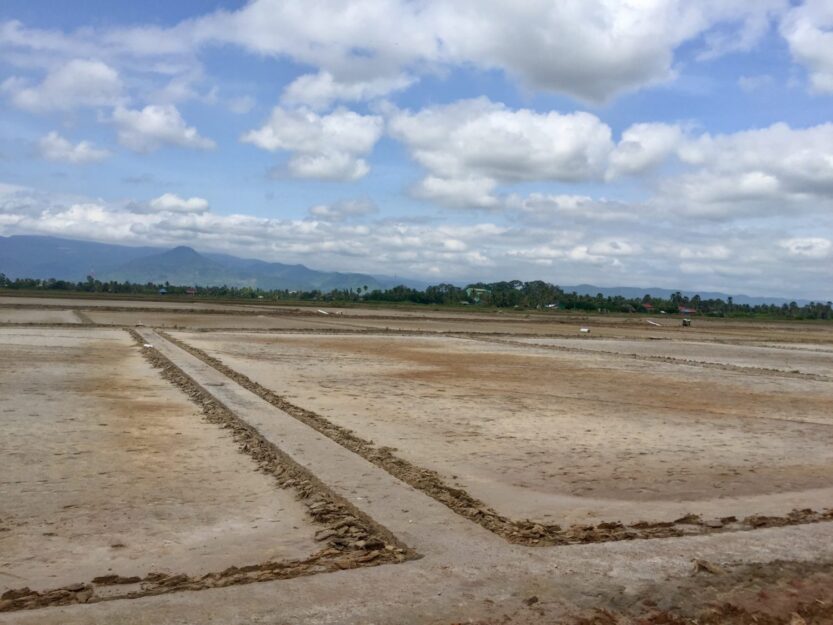
There are several salt flats between Kampot and Kep area and your tuk tuk driver will be sure to know which one to take you to. Dad and I visited one during our tuk tuk tour but it was, in all honesty, disappointing, as it was the wrong time of year. It has to be hot and sunny for salt harvesting as the sun is needed to evaporate the water leaving the salt behind. We visited at the end of the rainy season so there really wasn’t much to see. However, Andy and I have visited before in the hot season during the salt harvest and it was in heaped in sparkling white piles as far as the eye could see.
I’d recommend only adding this to your itinerary if you visit in the dry season. You’ll then be able to observe the workers gathering the salt into piles, loading it into woven baskets, then carrying the heavy loads to nearby warehouses. It’s a fascinating process, but extremely labour-intensive for the workers who toil all day under the hot sun.
Phnom Chhnork Cave
Located about 8 km northeast of Kampot along dirt roads is Phnom Chhnork Cave which contains the remains of a brick temple. A staircase of over 200 steps leads up the hillside then down into the cave which is full of stalagmites and stalactites. One formation vaguely resembles an elephant and another a calf. It’s possible to climb through the main cave to a smaller one but you’ll need a head torch and trainers or walking shoes with good grip. There are likely to be several kids hanging around who will happily guide you through the caves in exchange for your loose change,
Dad and I didn’t stop at the cave, mainly because Andy and I had been before and I realised then that clambering over slippery, razor-sharp rocks, through small, tight spaces in the pitch black wasn’t for me. If you get claustrophobic or aren’t relatively fit and mobile I’d suggest giving this a miss.
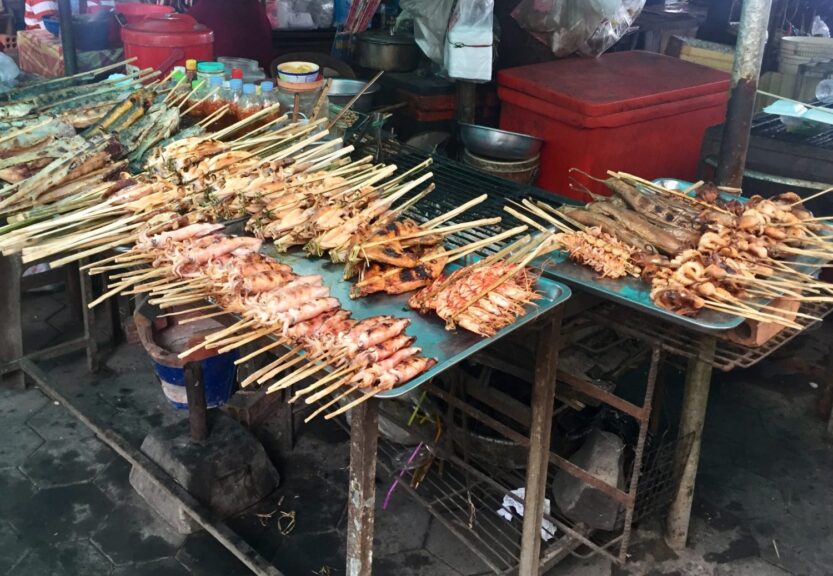
One of the main reasons to visit Kep is to visit the buzzing Kep Crab Market located near the seafront just as you enter the town. Try to visit the market in the early morning when you’ll be able to watch the locals bringing in their catch. They wade just offshore filling plastic baskets full to the brim with freshly caught blue crabs. The crabs are then sorted to be sold at the Crab Market and to restaurants.
Dad and I only gave the Crab Market a fleeting glance as we were ravenous and I was keen to take him to my favourite Restaurant to try the famous Kampot Pepper Crab instead. However, Andy and I have been to the market several times previously and have always found it fun. We like to wander around looking at the range of fresh (and dried) seafood on offer. You can even buy what takes your fancy and have it barbequed or fried to eat there and then! If seafood isn’t your thing there are lots of other food options you could try instead.
Koh Tonsay (Rabbit Island)
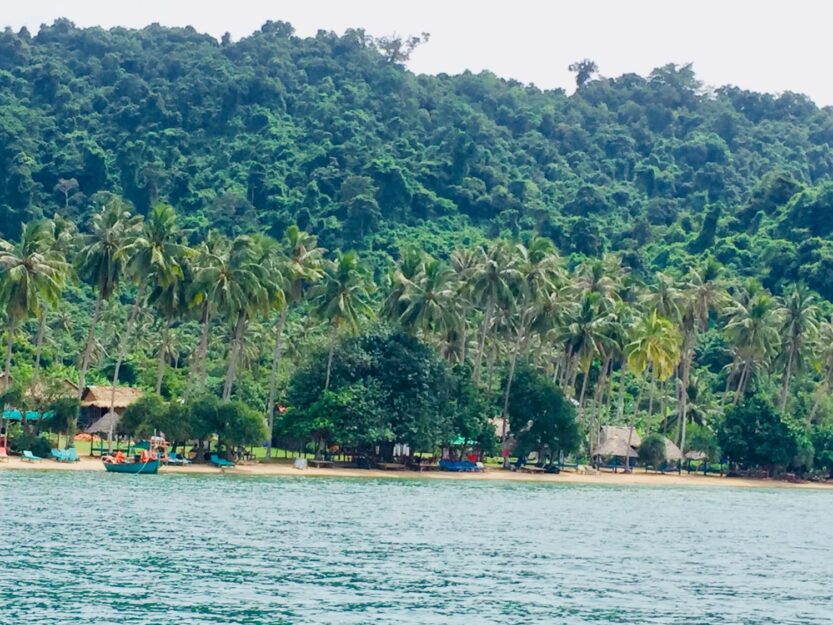
A short way off Kep but also accessible from Kampot is the island of Koh Tonsay or Rabbit Island as it’s also known due to its shape. It’s one of the least visited Cambodian islands and is extremely rustic, with just a few beachfront restaurants. You won’t find any wifi there and there isn’t much to do other than chill on the beach or in a hammock with a book. Unless of course, you feel like exerting yourself a little for a refreshing dip or snorkel in the sea to cool off.
It’s the perfect place to slow down and relax for the day. You could even make a mini-break of it if you’re happy to rough it a little in the beach hut accommodation set behind the restaurants.
There are three options to reach Koh Tonsay, two from Kep and one from Kampot:
Community boat that leaves Koh Tonsay Pier in Kep at 9 am and 1 pm each day and returns at about 3 pm – check time. You can buy a ticket for this at the Community Boat Office in Kep for $8 USD (£6.34) return.
Private boat that will take you and return you at any time before 5 pm for $25 USD (£19.80) return per boat. The boat can be booked and paid for at a little shack at the start of Koh Tonsay Pier and can fit six foreigners or eight locals. This is more flexible than the community boat and cheaper for four or more people.
Crab Shuttle from Kampot which leaves Kampot, opposite Rikitikitavi at 9 am. It reaches Kep at 11:30 am and arranges for you to join the community boat at 1 pm. As per option one you’ll return on the community boat at about 3 pm before joining the Crab Shuttle back to Kep. This costs $18 USD (£12.70) per person and can be booked via the Crab Shuttle Facebook page.
We took a private boat for convenience and to maximise our time on the island. It wasn’t the cheapest option as there were only three of us, but we didn’t have the extra days to allow us to stay the night. The first and last options only give you a couple of hours on the island if you’re day-tripping.
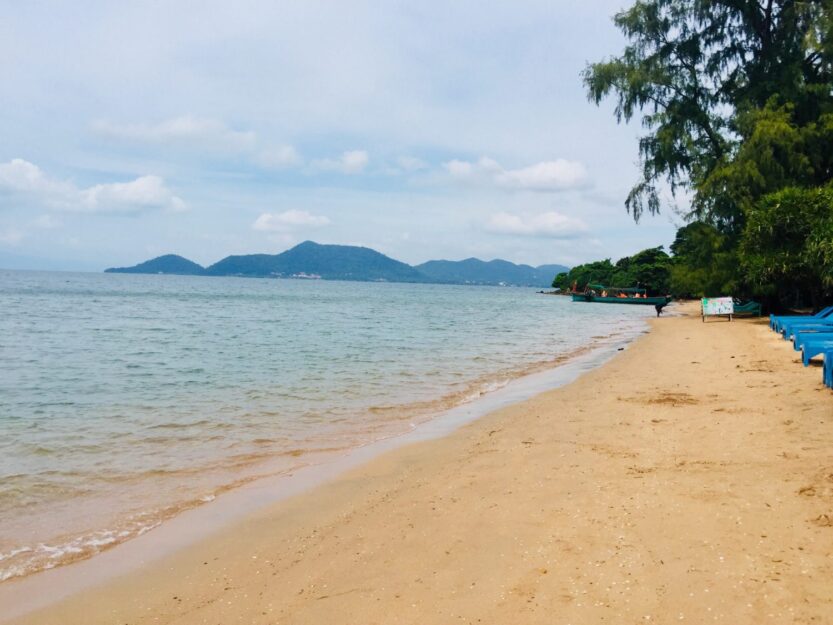
The boat to Koh Tonsay was easy to arrange and the island was almost deserted as the domestic tourists visiting during the Water Festival had left. We spent the majority of the day lazing on the beach, reading and drinking fresh coconuts. Andy and I left Dad to snooze a couple of times whilst we swam and snorkelled. The snorkels for rent weren’t in particularly good condition so if you have your own snorkel and mask, definitely take it along.
Watching a local fishing boat come in with fresh fish and crabs reminded us to interrupt our relaxing for lunch. We ate at the nearest restaurant and ordered a delicious seafood feast. We had grilled king prawns, a whole fish with garlic and lemongrass, and fried crab with Kampot pepper. They were good value for the portion size and freshness of the seafood.
Later Andy and I took a short trek through the jungle to another beach where Andy found the biggest starfish I’ve ever seen!
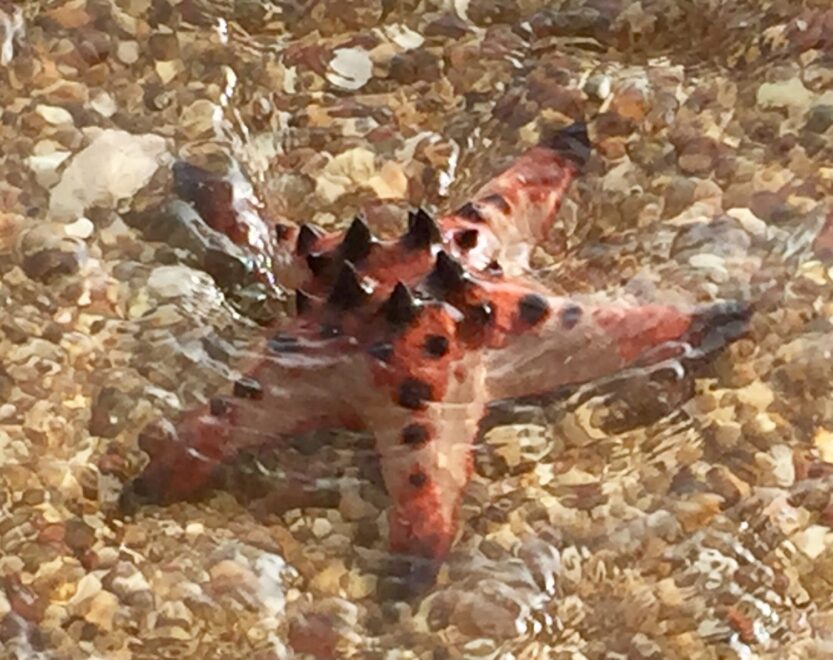
We had a fantastic day out on Koh Tonsay; if you have the time I’d highly recommend at least a day trip there, if not longer. It’s one of my favourite things to do around Kampot and Kep.
Other Activities In and Around Kampot and Kep
Despite visiting Kampot and Kep a few times over the years there are still several things we haven’t managed to see and do yet including:
Sunset Firefly Cruise – is a lovely way to spend 3 hours of an evening in Kampot. You can watch the sunset as you move upstream, and then once it gets dark, if you’re lucky, you’ll get to spot glowing fireflies in the trees lining the banks. Many operators in town tout these cruises along the riverside so you can take your pick. One of the most recommended is that offered by Captain Chim’s Guesthouse. For $5 USD (£3.53) you get a two-hour cruise with a beer or soft drink included.
Watersports – many of the riverside guesthouses in Kampot offer a whole host of watersports for visitors to have a go at. These include kiteboarding, paddle boarding, kayaking, fishing and much more.
Bokor National Park – once one of Kampot and Kep’s most popular attractions this 1,500 square km park is the home of Bokor Mountain and Hill Station. There’s a small entry fee to the park, then there’s a windy road that snakes around the mountain to the top with some great views en route.
The Hill Station at the top is a collection of old 1920s buildings including a casino, hotel and church. The trip is best done by scooter, but you could also take a more expensive taxi or a tour. Tuk tuks aren’t recommended as they’ll struggle to reach the top.
Last we heard, the buildings at the top are being renovated so you may find it’s lost some of its eerieness and charm. Having said that as we haven’t been there ourselves I can’t confirm or deny that.
Popokvil Waterfall – is set at the top of Bokor Mountain and has an additional 2,000 riel (£0.35) entry fee. It’s only worth visiting in the wet season as in the dry season it will be just a dribble. When there’s water in the waterfall you’ll find locals enjoying picnics and splashing around in the water.
Kep National Park – is overlooked by many, but it makes for a nice visit if you’re into hiking, although don’t expect anything too challenging. The entry fee is only $1 USD (£0.71) and there are several well-marked trails through the jungle including an 8 km circular loop. Along the jungle trails, you should see some of the flora and fauna of the park, including, if you’re lucky monkeys, squirrels, birds and butterflies.
Where to Eat and Drink in Kampot and Kep
Nowadays Kampot has quite a good selection of places to eat and drink, more so than the smaller towns of Kratie and Kampong Cham that I visited earlier in the year. We tried a few out during our stay but sadly only had the chance to eat in one place in Kep during our short visit.
Where to Eat in Kampot
Like many riverside towns in Cambodia, most of the places to eat in Kampot are along either side of the river or up the streets leading off it. The area of river running north and south of the old bridge is where you’ll find the majority of them. We didn’t have a bad meal while we were in town and enjoyed all the places we ate – here are a couple of favourites.
Rikitikitavi Restaurant and Bar is set on the riverside road and offers great river and mountain views from its first-floor seating area. It’s one of the most popular restaurants in Kampot and serves a fantastic selection of Western and Khmer dishes. We were impressed with the food, atmosphere and service and warrants the sparkling reviews.
In addition to the restaurant, there is an excellent, well-stocked balcony bar. The perfect spot to escape the heat of the day with a cold drink, or to relax with a cocktail as the sunsets behind the mountain.
They also often have a happy hour between 4 pm and 6 pm offering 2-for-1 cocktails, made with top spirits brands. Alongside their excellent cocktails, there’s also a broad selection of reasonably priced wines, soft drinks, fresh fruit drinks, and shakes.
Rusty Keyhole is again on the riverside road and is probably the oldest restaurant in Kampot. It’s famous for its humungous ribs. We’d been recommended this place by numerous people over the years but had never tried it. When we finally got there, we made sure to see if their ribs lived up to their reputation, which they did.
Instead of a rack of ribs with a thin layer of meat, this appeared to be the entire side of a pig! Andy and I opted for the half rack each smothered in their secret recipe sauce. I’m glad we didn’t have a whole rack each as tempted because we’d never have finished them. There are other non-rib options such as Chicken Pesto Pasta which Dad had.
Where to Eat in Kep
There’s a strip of restaurants along the waterfront next to the Crab Market in Kep but they are much of a muchness. Andy and I have only ever eaten in one restaurant – Kimly, which has a great reputation. I also took Dad there for lunch on our tuk tuk tour:
Kimly Seafood Restaurant is about a third of the way along the waterfront from the Crab Market. It has an extensive list of fresh seafood and although prices are slightly on the high side, it’s justified by the portion size and quality.
After several previous great visits, we took Dad there to sample the famous Kampot Pepper Crab. As always it was delicious, but very, very messy! Be prepared to be up to your elbows in pepper sauce by the time you’ve finished!
Remember to wash your hands before diving into the crab, or use some hand sanitiser. This is real ‘finger food’ and you don’t want a case of traveller’s tummy ruining your trip.
Several other places in Kep could be worth a look for food and drinks which Travel Fish have posted about in Places to Eat and Meet in Kep.
Where to Stay in Kampot and Kep
There are many hotels and guesthouses to choose from in Kampot and Kep. Bear in mind though that the majority are to be found in Kampot which is where Andy and I usually stay, including with my Dad, although I have stayed in Kep once with a couple of girlfriends.
Below is an overview of some places to stay in Kampot and Kep.
Kampot Accommodation
There’s a good range of places to stay in Kampot, to suit all budgets and styles. Accommodation is mostly situated in the town centre but there’s also a small cluster on the other side of the river. We highly recommend staying on the riverfront if you can.
Sadly Riverfront Boutique hotel where we liked to stay is now closed. However, there are plenty of other places to choose from.
Ecran Riverfront Guesthouse is a good budget choice, it has a fantastic central location right on the riverfront and just a short walk from the night market. Its rooms are simple, but clean and comfortable, and the terrace is the perfect place to watch a stunning Mekong sunset.
Rikitikitavi is a small, friendly boutique hotel, right on the riverfront. It’s attached to the restaurant and bar mentioned earlier in the post, which has great food and an amazing terrace for sunset drinks. The rooms are nicely decorated and comfortable, and the owners and staff are friendly and helpful.
The Columns is a good choice if you’re not fussed about being right on the riverfront. Housed in several French colonial buildings, it’s set just back from the river, down an alleyway in the Old Market area. Beautifully renovated, it has nicely furnished, comfortable rooms, some with a balcony. Slightly more expensive than the previous options, it’s still good value and the rate includes a tasty breakfast.
For something more high-end, check out Castle Bayview Resort and Spa on the other side of the river, with both river and mountain views This is the best luxury hotel in Kampot, where you can enjoy a swimming pool, spa and on-site restaurant. This is the place to stay for some rest and relaxation.
Kep Accommodation
Being a much quieter destination than Kampot, there aren’t so many places to stay in Kep, however, there are still enough options, should you choose to make it your base for exploring the area.
The accommodation is quite spread out – dotted from Kep beach to the crab market and further near to the coast or the edge of the national park.
The only place I’ve stayed in Kep is Q Bungalows with two of my girlfriends. It’s set back from the seafront, about a 10-minute walk from Kep Crab Market, in a peaceful location at the bottom of the mountain on the border of the National Park. The bungalows sit amongst lots of jungle vegetation, and we loved the pool which is long enough to swim lengths.
There’s also a bar and restaurant on-site and we found the room rates to be extremely reasonable.
A great option for budget travellers is Captain Chim’s Guesthouse. Set amongst tropical gardens, it’s simple but clean and comfortable with friendly owners. It’s also very close to the pier where the boats leave for Koh Tonsay (Rabbit Island), one of Cambodia’s best islands, so it’s handy if that’s your next destination.
We’ve also heard good things from fellow expats and travellers about Khmer Hands and Mealea Resort. And, if you’re looking for something a bit special check out Veranda Natural Resort which is a hilltop resort, overlooking the sea, located right in Kep National Park.
Kampot and Kep Transport
How to get to Kampot and Kep depends on where you’re starting your journey from. Remember bus companies and schedules are prone to change in Cambodia, so only take the below as a rough guide. Be sure to double-check before finalising plans.
Getting to Kampot and Kep
The most common routes to Kampot and Kep are from Phnom Penh, Sihanoukville, and Siem Reap, by road or a combination of plane and road. Most buses, mini-vans and taxis can be booked from the majority of hotels, guesthouses and travel agencies or online via CamboTicket for convenience.
From Phnom Penh – It’s about a two-and-a-half to three-hour journey by road from Phnom Penh to Kampot depending on your mode of transport. This makes Kampot and Kep a good next destination after completing your Phnom Penh itinerary.
The main options are by bus, mini-bus (van), or taxi. Probably the best bus company to use is Giant Ibis which has a mini-van taking this route twice a day at 8 am or 2:45 pm for under $9 USD (£6.35) plus a $1 USD (£0.71) booking fee for online bookings via their website.
Giant Ibis doesn’t run directly to Kep from Phnom Penh but many other companies do which can again be booked via CamboTicket. Alternatively, you can get a tuk tuk or taxi between Kampot and Kep for around $12 – 15 USD (£8.47 – £10.59) and $20 USD (£14.11) respectively.
If budget isn’t an issue or comfort is your main priority a direct taxi from Phnom Penh to Kampot should cost from about $50 USD (£35.28), and to Kep from about $55 USD (£38.81), increasing depending on the vehicle and number of passengers. Again you can book taxis from your accommodation or an agency.
From Sihanoukville – It takes about two to two-and-a-half hours to get from Sihanoukville to Kampot by road about three hours from Kep. There are mini-vans on both these routes from 8 am for about $6 – $8 USD (£4.23 – £5.65). These can again be booked online via CamboTicket or from your accommodation or an agency. A taxi will set you back about $50 USD (£35.28) again depending on the vehicle and numbers.
From Siem Reap – To get to Kampot or Kep from Siem Reap you can either go directly (hopefully) by taxi or indirectly via Phnom Penh or Sihanoukville, which is what we did when we were digital nomads in Siem Reap).
The first stage of an indirect journey could be by bus or plane. By taxi, it will cost from $150 USD (£118.31) for the car and should take around five hours if it goes directly. Be sure to agree on a direct taxi when you book it though as many companies tell you it’s direct then go to the centre of Phnom Penh and swap taxis. This happened to us and added at least an hour to the journey and is frustrating, to say the least.
If going from Siem Reap via Phnom Penh often the cheapest way but longest is by bus. It generally takes around six hours and costs between $6 USD (£4.23) and $13 USD (£9.17) if you book through CamboTicket. Taking an overnight bus with Giant Ibis is closer to $16 USD (£12.40).
If you’re strapped for time, a flight can be a good option. Sometimes you can find deals which aren’t much more expensive than a bus. Check flights on Skyscanner for the best deals:
JC Airlines is also worth checking, although they can only be booked through the Ctrip website.
You can also fly to Sihanoukville which is our preferred option if we can find cheap flights. I don’t recommend getting a bus or taxi to Sihanoukville first as these aren’t direct and detour via Phnom Penh, making for a long and uncomfortable journey.
Once you get to Phnom Penh or Sihanoukville, the second part of the journey will be the same as one of those mentioned above.
Getting Around Kampot and Kep
The best way to get around Kampot and Kep towns is by foot as everything is within walking distance. The riverside and surrounding countryside are beautiful and interesting so a nice way to spend some time is exploring by bicycle or scooter. You can rent bicycles from many hotels, guesthouses, and other businesses in the towns for a small fee. I’m not sure about scooters though as I don’t ride. Ask at your accommodation and they should be able to point you in the right direction for either mode of transport.
If you want to explore even further afield your best bet is by tuk tuk as it allows you to see more than by taxi; just be prepared for a very bumpy ride. The best way is to combine several attractions with a countryside tuk tuk tour as we did which should cost you between $25 and $30 USD (£17.64 and £21.17), depending on where you want to go.
Our tuk tuk collected us at about 9 am which gave us plenty of time to see everything we wanted to. Be sure that your tuk tuk driver knows exactly where you want to go. For example, if you want to go to a specific pepper plantation make sure they understand upfront. If you’re not clear they’ll understandably take you to the places where they get the best commission.
To fully immerse yourselves in the heart of Khmer culture and history, you really should include a visit to the colonial towns of Kampot and Kep during your time in Cambodia.
Have you visited Kampot and Kep? Have I missed anything else there is to see or do off the beaten track there?
Planning Your Trip to Kampot and Kep?
Planning your trip to Kampot and Kep in Cambodia? Here are some of our recommended useful resources to help you have the best time possible.
|
● TRAVEL INSURANCE IS AN IMPORTANT CONSIDERATION! World Nomads offers cover for travellers in over 100 countries and True Traveller is a great option if you’re from the UK or EU. SafetyWing is another solution, particularly for digital nomads and long-term travellers. ● Find amazing flight deals on Skyscanner, Kayak, and AirAsia. ● Compare rental car prices on Rentalcars.com. ● Booking.com and Expedia usually have the best hotel prices. ● Our go-to for self-catering accommodation is Vrbo. ● Discover fantastic trips and activities with Viator and GetYourGuide. ● Check out Bookmundi, G Adventures, and Intrepid Travel for group holidays and tours. |
Kulen Mountain Day Trip |
Enjoy this post? Pin it for later!
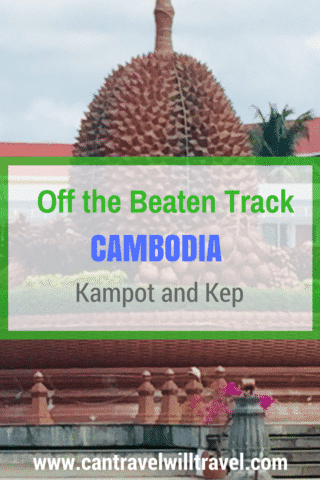


Everybody going from Sihanoukville to Kampot because of the Chinese invasion going on in Sihanoukville, or so I’ve heard.
I can really recommend Kampot and Kep ! Thank you for this article.
No worries – some of my favourite places for a break from Siem Reap.
Yes I’ve heard the same, but friends in
Cambodia say it’s still nice to visit!
I’m returning in October to live in Cambodia in October so I’ll check how it is there how and update this post if necessary!
I haven’t been to Cambodia yet but I would love to go! I like the idea of a tuk tuk tour, and a trip to the pepper plantation sounds fascinating! I would definitely check out the crab market too, that sounds delicious!
It’s an amazing country – I highly recommend it. Tuk tuks are my favourite was of getting around in the countryside.
I love crab, so I’d definitely be all about visiting the crab market and eating as many freshly cooked crabs as I could. That alone would be reason enough for me to head to Kep to check it out.
Me too – that was one of my main first reasons for visiting.
Cambodia is still somewhere we have not yet visited. The Durian roundabout made me laugh. We do recall the durian smell from touring in other parts to SE Asia. If the blue crab sculpture means there is lots of fresh seafood, we will definitely want to visit Kep and the crab market. A tuk tuk tour in the country would be so much more relaxing than our last one in Bangkok!
If you get a chance definitely visit – it’s fantastic; it’s definitely a more relaxing tuk tuk ride than in Bangkok that’s for sure 🙂
Nice guide! Rabbit Island seems like a great place to spend one full day in! 🙂 It’s nice to see Cambodia outside of Phnom Penh and Siem Reap!
Thanks – yes Rabbit Island was great for a relaxing day trip, beach time, BBQ and a bit of snorkelling.
You see some wacky things while you travel, but why Kampot would have a durian in the centre of a roundabout escapes me. I love crab so my first stop would definitely be the market. Great tip about getting there early to see the catch arrive. That’s exactly the kind of thing that I enjoy doing.
Apparently Kampot’s famed for its durian, which is why they put one on their roundabout…only in Cambodia ?
I missed both of these cities both times I was in Cambodia. I really love the kitschy stuff like the durian roundabout! It’s so funny! I would also definitely visit Koh Tonsay. It looks like such a gorgeous place! Plus, it’s so affordable to get there!
They’re all definitely worth a visit if you ever return!
I love those blue crab statues! I think I’d be hanging out in the market for crab if I visited Kep. It’s a fascinating area and one I knew nothing about, so thank you for sharing
Me too and the Kampot Pepper Crab is delicious…and very messy to eat!
We are yet to make it to Cambodia and have to admit that we haven’t heard about Kampot and Kep until now. Kep and Kampot look like a quaint town, exploring the countryside on tuk-tuk sounds like fun. We have never been to a Pepper Plantations or even the Salt Flats so it would definitely be on the list.
I hope you get to visit Cambodia one day – you’re sure to love it. I’ve written several about several other places in my Off the Beaten Track Cambodia series so feel free to have a look to get an idea of what else Cambodia has to offer 😀
I have not heard of Kampot and Kep at all! I see why you call them off beat places to visit – they seem to not be touristy at all and that is a major reason for me to want to explore the area. A countryside tuk tuk tour sounds right up my alley. Also, Rabbit Island and Salt Flats look pretty cool!
Fingers crossed they stay that way. They’re quite well known amongst the expat communities of Siem Reap and Phnom Penh as they know they’re lovely places to visit away from the hustle and bustle of the cities. However many people that come to Cambodia on holiday/ vacation are still not aware of them which is why I wanted to share this info.
I love getting off the beaten path in South East Asia. We took a bike tour through Thailand and we saw so much more authentic culture than we saw in Bangkok our you’d see in Siem Reap. I love experience like this where you can enjoy the people and the landscape and not a developers idea of what paradise looks like.
Me too – it’s my favourite thing to do, I did a bike tour through central Vietnam and it was amazing. Can’t wait to explore more off the beaten track in SE Asia.
Never been to Kampot and Kep. Thanks for sharing all helpful tips. It’s definitely inspiring to visit Cambodia to explore Kampot and Kep 🙂
Definitely worth a visit!